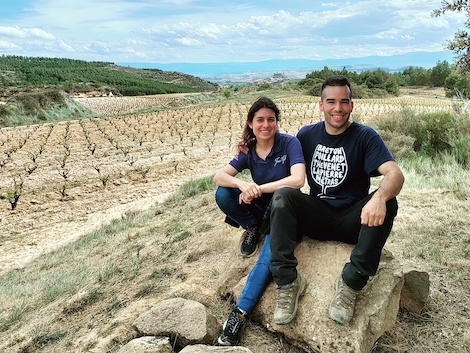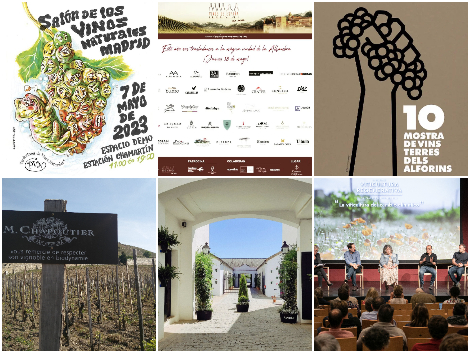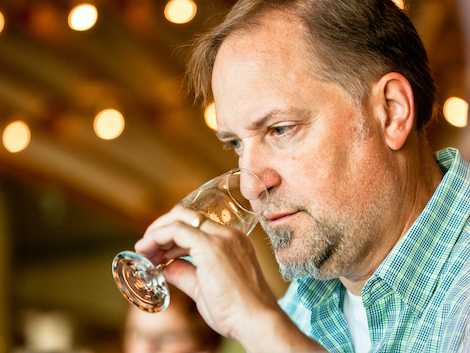Vignerons de la Sonsierra: crafting fine wines from a medieval cellar

As a third-generation winegrower from San Vicente de la Sonsierra in Rioja, José Gil had every chance of being involved in the wine business. When he graduated in oenology in Logroño in 2010, he took a job at Olmaza, the family winery, but instead of settling in and following the established path, he decided to look to the future, while keeping an eye on the past.
His grandfather Ángel had always been a source of inspiration, both in his approach to the vineyard and in his special way of living wine, but José wanted to achieve more than just making good cosechero wines from plots in special places like La Cóncova or in one of the seven valleys with different exposures and soils in San Vicente de la Sonsierra. On its own, this village perched above the Ebro river has almost as many hectares as the whole of DO Priorat.
José gradually began to buy plots in San Vicente. He also carried out his own experiments making garage wines at home, visited other wine regions to open his mind, meet likeminded artisan producers and taste their wines. In 2012 he bought and restored La Cueva del Espino, a small medieval cellar on the northern slope of the castle, two doors up from Benjamín Romeo's, and in 2016 he released his first 2,000 bottles of La Cóncova to the world.
Pruning, ploughing and driving the tractor
He does not have warm memories of 2017, when the frost prevented him from harvesting, but he has fond recollections of 2018, not only because he was able to make wine again and international critics began to notice him, but also because his personal and professional life was completely transformed when he met Vicky Fernández, a Uruguayan living in Bilbao, partying on Calle Laurel in Logroño. Vicky worked in the hospitality business and knew nothing about wine-growing, but with passion, character, hard work and a great deal of intuition, she managed to break through the stereotypes and become one of the two faces of Vignerons de la Sonsierra, as the couple's project is called.

Nowadays, José and Vicky share all the work, from bottling to pruning, driving the tractor and ploughing. "I have been lucky in that José has always been willing to teach me and to rely on me. He encouraged me to get on the tractor and never minded if I accidentally drove over a vine when I started. He has always trusted me and that has given me the confidence to try everything," says Vicky. "José insists on cleaning the winery himself, probably because he doesn't trust anyone else to do it, and of course I let him," she chuckles.
For the couple, who draw inspiration from the vignerons of Burgundy but also from village neighbours such as Abel Mendoza, 2020 was a turning point. "That was when we started to work seriously on our project," explains José, who owned five hectares and sold the grapes to Olmaza until 2021, when he became independent of the family winery. "We abandoned conventional farming, we bought the dodge plough, which turns over the grass between the vines, protecting the trunk without compacting it, we stopped using herbicides and now only use copper sulphate and sulphur powder when necessary". They do not have official organic certification, but this is not something they worry about. "Our importers and distributors see how we work when they visit us and that is the only guarantee they need.”
Vicky and José, aged 34 and 33 respectively, grow six hectares in San Vicente and Labastida, which they bottle under their own brand, and another 2.5 hectares in Briones, which they sell to their friend Miguel Merino. They plough, prune and desucker La Loma, Miguel's plot planted in 1946. Together with Miguel and other like-minded local producers such as Ricardo Fernández (Abeica), Miguel Eguíluz (Cupani), Álvaro Loza and Carlos Sánchez, and sommelier Iván Sánchez (Venta Moncalvillo), they formed Martes of Wine, a group that not only meets to blind taste wines from around the world and travel to vineyards, but also to exchange ideas and support each other. Now José and Vicky, along with the rest of the Martes of Wine gang, are excitedly preparing their first joint event, open to the public, on 3 June in San Vicente.
A white wine named Maia
Like the rest of their wine tasting friends, the couple seek to capture the diversity and wealth of nuances of the villages and places where they grow their vines, and although their aim is to improve the range of wines they produce, they are not closed to releasing new cuvées.
In fact, in addition to the five reds on the market, there will be a new white from the 2021 vintage called Maia, after their daughter, who was born in the spring of 2022. It is made from Viura (and Garnacha Blanca in the 2022 vintage) from Labastida and San Vicente, and is produced in 500-litre barrels and demijohns without malolactic fermentation. "We like the way the aroma of the grapes and the acidity are maintained in the demijohns, but also the contribution of the oak. Of course, if we talk about specific sites, we must use high-quality barrels," argues José. In their case, they prefer artisanal cooperages from Burgundy and central France, and they also have some seasoned Radoux barrels for their village reds.
In the near future they may also release a Garnacha from Santa Torrea, three terraces of old northeast-facing vines on limestone soil that they rent in this part of San Vicente. When they leased it a couple of years ago it was full of weeds and had stunted spurs, but it has gradually come back to life and is already showing its first leaves and buds. "If we like the grapes this year, we'll make a single vineyard wine; if not, they'll go into the village wine," says Vicky as she drives us in her small but sturdy Seat León up the road to Tasugueras (pictured below), two beautiful little plots of 80-year-old vines in sandy soil, surrounded by apple trees and bushes of blackberries and sloes. Tractors can't get in here, so they have to cultivate with a small plough around the trunk, but they don't mind. They believe in the potential of these grapes, which, although they are currently produced separately, are also used in the village wine.

If 2020 marked a turning point in terms of improved vineyard management, 2021 was a major quantitative leap for Vignerons de la Sonsierra, as they increased production from 6,000 to 24,000 bottles, mainly of their San Vicente wine (rising to a total of 28,000 bottles in 2022).
Until then, they had been making their wines in a small space in Olmaza, but in 2021, after a fruitless search in and around San Vicente, they managed to rent a bodega in Briones, just opposite Bárbara Palacios, that suited their needs. "It has a hydraulic press, a peristaltic pump, an air-conditioned room for storing the bottles and concrete tanks in which we now ferment some of our wines," explains José.
After fermentation, part of the wine remains in Briones and the rest is transported by van to the Cueva del Espino, the only wine cellar still used for ageing wine on the slopes of the castle of San Vicente. With panoramic views of the Sierra Cantabria mountains and the perfect temperature and humidity conditions for wine conservation, the cave is not only a wine cellar, but has also served as a meeting place for friends and even as a chapel for the couple's own wedding.

Range of wines
Their range begins with the village wines, a category they consider fundamental to building their project with honesty and from the base up. "Our idea is to continue to refine this style, looking for elegance and fluidity, making wines that are accessible to everyone; without a doubt, the village wines are our most important category," explains Vicky.
The San Vicente village wine (16,000 bottles, €24) is the winery's largest production cuvée, blending Tempranillo and Garnacha vines between seven and 100 years old with some white grapes. "We always add some whole clusters, especially Garnacha," says José, who praises the 2022 vintage of this wine, which is still in barrel. "We have gained texture on the palate and we are ageing it for longer. We are gradually learning and getting closer to the style we like."
Since the 2021 vintage, the wine has been fermented in concrete and aged partly in these tanks and partly in 500-litre barrels in the castle's cave. "We like the way concrete treats the wines," explain the couple. "It preserves the fruit very well and the wines age slowly, opening them up and making them more expressive. And when the concrete part is mixed with the oak-aged wine, the whole ensemble gains in complexity."
While the San Vicente wine has aromas of scrubland herbs and deep, dark fruit, the Labastida version is more subtle and refined, with softer tannins and more immediate fruit, thanks to the fact that the vines in this Alavesa village are less exposed to the north wind. With a more limited production (3,600 bottles) and aged entirely in oak, but with the same price and grape blend as its brother from San Vicente, part of the vineyards (60 years old) are leased and another part (80 years old) is owned and tended by Iñigo Perea, one of the young people mentored by Remelluri in its project to support local winegrowers. Iñigo's name also appears on the label since the 2021 vintage.
Since 2016, they've been making José Gil El Bardallo (670 bottles, 3,000 from 2022, €39), a 35-year-old blend of Tempranillo and 2% Viura from a northeast-facing site with chalky soils next to Labastida. According to José, "it delivers fine, elegant wines that speak of the soil, with crisp black fruit and floral notes.”
El Bardallo is more delicate and vertical than José Gil La Canoca (similar number of bottles and price), a site with more silt and clay below Peciña that produces wines with good fruit in the foreground and more volume, power and structure. La Canoca is also fermented in concrete and aged in oak, but both vessels are pleasantly unobtrusive on the palate.

With its freshness, purity and energy, Camino de Ribas (600 bottles, €50, formerly La Cóncova) is at the top of the Vignerons de la Sonsierra quality pyramid. It comes from two plots in La Cóncova (pictured above), between El Bardallo and La Canoca, a valley with a greater Atlantic influence and good aeration, where the contours of the Toloño mountain range let in the cold north wind. At one end, José and Vicky have planted a hectare of Garnacha and Moscatel on sandy loam soils with iron oxide and sandstone rocks, but they also pick Tempranillo and Garnacha from the 140-year-old plot planted on sandy loam with calcium carbonate veins, which José believes gives the wine a special touch. El Fugas, which was made in 2020 from a plot in Briones, is no longer being produced.
Although they have multiplied their production, José and Vicky's wines are sold out every vintage. They sell by allocation, evenly split between Spain and abroad, although they could sell more overseas if they wanted to. "Even if it is only two cases, we want them to go to those who appreciate the wines and care enough to keep in touch with us beyond the actual sale," they say.
And can you live comfortably on 24,000 bottles, I ask. "We invested all our savings to start the project, but now that we have vineyards and machinery, we can make a good living provided that we charge reasonable prices for our wine," explain José and Vicky. "You can't go crazy and sell a bottle for €50, because you'd have to spend your life on a plane. It's good to look after the markets, but we belong here; our wine is only made with us in San Vicente.”

Yolanda Ortiz de Arri
A journalist with over 25 years' experience in national and international media. WSET3, wine educator and translator
NEWSLETTER
Join our community of Spanish wine lovers






